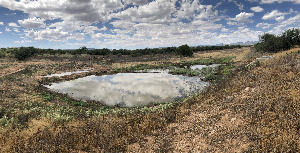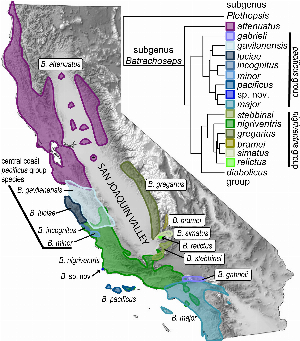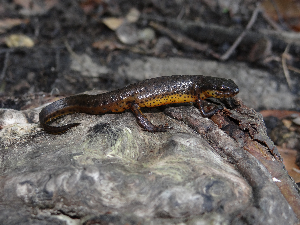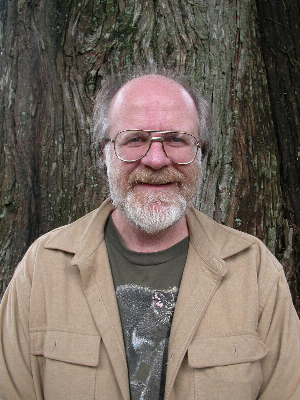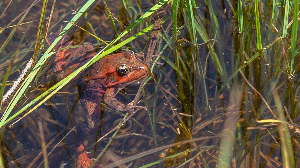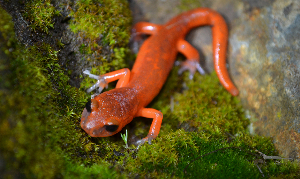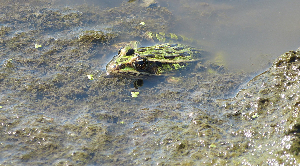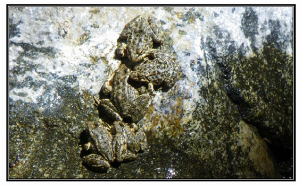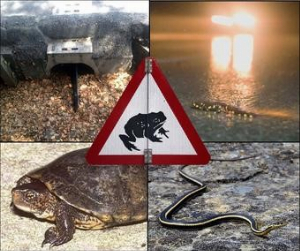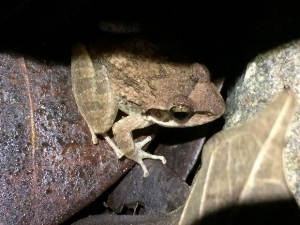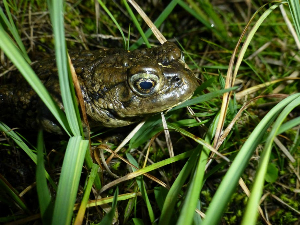Search ARMI Database
Search term(s)
Contribution Number
Search Results
86 record(s) found.
News & Stories Update to annotated bibliography of grazing effects on amphibians and their habitats
USGS researchers recently published an update to the 2020 ‘Annotated bibliography of grazing effects on amphibians and their habitats’ data release, a global synthesis of literature pertaining to livestock grazing effects on amphibians and their habitats. The update includes an additional 10 grazing-related publications that were released between 2020 and 2021. The data release features an interactive search tool, which has also been updated. Users of the annotated bibliography search tool can query records by user-defined criteria and output results in report format. This tool aids users in synthesizing research related to a range of specific questions and should assist land managers in evaluating and implementing grazing while maintaining habitat for wetland amphibians.
You can access the updated search tool here: https://doi.org/10.5066/P9GGPPF7
News & Stories The return of red-legged frogs
Multiple partners from national and international nonprofits, government agencies, private landowners come together to change the course of the frog’s plight.
Read the full story here: https://www.fws.gov/cno/newsroom/Highlights/2021/Red-Legged-Frog/
News & Stories ARMI Scientists Assist NPS Monitoring Program with Symposium and Program Review
During December 8–10, 2020, the NPS-Greater Yellowstone Network hosted a virtual three-day amphibian and wetland science symposium entitled Linking Monitoring and Research to Amphibian Conservation in the Greater Yellowstone Ecosystem. This symposium highlighted work related to the NPS program that has monitored amphibian and wetland dynamics in Grand Teton and Yellowstone national parks since 2006. USGS-ARMI has been linked with monitoring program since the inception of the NPS monitoring program and assisted with organizing symposium presentations.
The three-day symposium served two important purposes. The first two days were intended to bring together practitioners of amphibian monitoring and park natural resource personnel with university, non-governmental scientists, and USGS scientists. Participants shared examples from their work and the current state of knowledge about research and monitoring of amphibians and their habitats. Reflecting the long history of ARMI research in the Rocky Mountains and on NPS lands, there were five presentations by ARMI scientists, and seven presentations highlighted on-going or recently completed ARMI research.
The third day was structured to provide a formal peer review of the network’s amphibian and wetland monitoring protocol. The eight reviewers, which included ARMI scientist Brian Halstead and former ARMI PhD student Paige Howell, offered recommendations to enrich and strengthen the Greater Yellowstone Network ’s ongoing monitoring efforts. In total, more than 60 people participated in the symposium and program review.
ARMI and the Greater Yellowstone Network will continue their collaboration by co-organizing a special issue in the journal Ecological Indicators. The issue will include several papers that highlight collaborative USGS-NPS research on amphibians, wetlands, and climate, as well as emerging tools and priorities for scientists and resource managers.
News & Stories Information from ARMI surveys guides management action in the Desert Southwest
The Buenos Aires National Wildlife Refuge (BANWR) has developed a new pond designed to replicate ciénega conditions that will provide habitat for the federally threatened Chiricahua leopard frog. Reintroduced to the Refuge after extirpation in the early 2000s, the Chiricahua leopard frog has colonized areas beyond the initial reintroduction sites, now inhabiting several human-made stock tanks on the Refuge. The species’ persistence on the Refuge depends on the ongoing eradication of invasive bullfrogs and the availability of water. In desert habitats such as BANWR, the ciénega (a Spanish word for wetland) is a marsh-like habitat that is critical for numerous desert-dwelling creatures. Ciénegas on BANWR are characterized by a spring or seep that saturates the soil and allows water to pool in small areas (Hendrickson and Minckley, 1985). Ciénega vegetation includes rushes, watercress, and smartweed; they are often bordered by cottonwood and willow trees which the Refuge will plant at the new ciénega once the water has settled into the excavated depression. The new ciénega on BANWR is plumbed, meaning that water levels can be modified and maintained in response to environmental conditions that range from multi-year droughts to heavy monsoon conditions (Bezy et. al. 2007).
ARMI has collected data at BANWR since 2000, gathering information about native species (e.g., Chandler et al. 2015, Jarchow et al. 2016, , Howell et al. 2018, 2020a), invasive species such as American bullfrogs and sunfish (Suhr 2010, Howell et al. 2020b), and disease (Sigafus et al. 2014). Models assessing occupancy and movement of the Chiricahua leopard frog indicate that water availability and permanency are critical components to the its persistence at BANWR. The Refuge has used this information to make decisions about management actions such as building plumbed ponds — a non-trivial action in terms of cost and logistics. The new ciénega will not only support the Chiricahua leopard frog but will provide water for many other species that call BANWR home including the federally endangered masked bobwhite quail, great blue herons, yellow-billed cuckoos, and pronghorn.
Bezy, J., C. F. Hutchinson, and C. J. Bahre. 2007. Buenos Aires National Wildlife Refuge, 373 Arizona. Desert Plants 23:3–44.
Chandler, R., E. Muths, B. H. Sigafus, C.R. Schwalbe, C. Jarchow, and B.R. Hossack. 2015. Realizing the potential of spatially explicit metapopulation theory for predicting extinction risk. Journal of Applied Ecology. DOI: 10.1111/1365-2664.12481.
Howell, P., E. Muths, B.R. Hossack, B.H. Sigafus, and R.B. Chandler. 2018. Increasing connectivity between metapopulation ecology and landscape ecology. Ecology 99: 1119-1128.
Howell, P.E., B.R. Hossack, E. Muths, B. Sigafus, A. Chenevert- Steffler, and R. Chandler. 2020a. A statistical forecasting approach to metapopulation viability analysis. Ecological Applications 30(2), e02038
Howell, P.E. E. Muths, B.H. Sigafus, and B.R. Hossack. 2020b. Survival estimates for the invasive American bullfrog. Amphibia-Reptilia.
Hendrickson, D. A. and W. L. Minckley. 1985. Ciénegas vanishing climax communities of the American southwest. Desert Plants 6 (3): 131-175.
Sigafus, B. H., C.R. Schwalbe, B.R. Hossack, and E. Muths. 2014. Prevalence of the amphibian chytrid fungus at Buenos Aires National Wildlife Refuge, Arizona. Herpetological Review 45: 41-42.
Suhre, D. O. 2010. Dispersal and demography of the American Bullfrog (Rana catesbeiana) in a 455 semi-arid grassland. M.S. Thesis, University of Arizona, USA.
News & Stories Urban Southern California is a Center of Diversification for Salamander Lineages
The Southern California Biodiversity Hotspot has a complex geological history and has a human population of about 24 million people. A recent study of genetic diversity across salamanders that occur here found high levels of localized diversity representing ancient mitochondrial lineages. Several of these lineages are very geographically limited and occur only within this urban matrix. Each of the three National Parks (Channel Islands National Park, Santa Monica Mountains National Recreational Area, and Cabrillo National Monument) in this southern California landscape will be important for the long term persistence of unique lineages that are almost micro-endemics to just these park units. Various Bureau of Land Management lands in this regional also house highly divergent lineages that could serve as conservation targets. Lastly, this work provides further support for the importance of the continued US Fish and Wildlife program of Habitat Conservation Planning within this Biodiversity Hotspot for conserving undescribed ancient patterns of genetic diversity.
News & Stories Devastating Salamander Chytrid Fungus Not Detected in National Survey Led by ARMI
The salamander chytrid fungus (Batrachochytrium salamandrivorans), commonly known as Bsal, has caused massive mortality of salamanders in Europe. There is a high potential for spread of the disease to North America through the international pet trade. Because North America has the highest diversity of salamanders in the world there is heightened concern about the potential for this devastating disease if it becomes established in the U.S. The U.S. Fish and Wildlife Service declared many salamanders as injurious under the Lacey Act and prohibits the importation of them to the U.S., but there are still potential means for the disease to spread. We conducted a large-scale surveillance effort for Bsal across the U.S. taking 11,189 samples from 594 sites in 223 counties within 35 U.S. states and one site in Mexico. We targeted sites that were believed to have high risk of Bsal introduction or where the consequence of a Bsal introduction would be high. We sampled for Bsal by swabbing amphibians, primarily newts, and attempting to detect the DNA of Bsal using standard genetic techniques. We found no evidence of Bsal in any of our samples, and our modeling suggests that it is highly unlikely that Bsal is widespread if it is present at all in North America at this time. The apparent absence of Bsal in North America suggests that efforts to prevent and prepare for its introduction are productive.
News & Stories Race to save rare California frog beats coronavirus lockdown
This week in the Los Angeles Times, ARMI biologists and Mexican biologists are highlighted in their effort to translocate eggmasses of the endangered California Red-legged Frog from San Pedro Martir range to the Santa Rosa Plateau and Santa Ana Mountains. Full article is available here: https://www.latimes.com/environment/story/2020-04-09/scientists-beat-coronavirus-lockdown-to-save-rare-california-frog
The official press release by the The San Diego Natural History Museum also covers this project (in which they play an important role): https://www.sdnhm.org/pressroom/pressroom_details/california-red-legged-frogs-returned-to-historic-range-in-southern-california/37/?utm_source=twitter&utm_medium=social&utm_term=035dad5c-1a08-40c5-b9af-94bd2ecc5a17&utm_content=&utm_campaign=usgs
We also earned a spot on the USGS Facebook page which can be seen here: https://www.facebook.com/USGeologicalSurvey/posts/3034689379910358
News & Stories Annotated bibliography of grazing effects on amphibians and their habitats
Livestock grazing is one of the most common land uses in the western United States, where multiple amphibians of conservation concern use habitats that are grazed. Despite the common intersection of grazing and sensitive amphibian species, there are very few reviews of research related to the issue. USGS researchers compiled and summarized literature pertaining to livestock grazing effects on amphibians and their habitats, with an emphasis on wetland-breeding species in the western United States. Users of the annotated bibliography can utilize an integrated search tool with user-defined criteria to query records and output results. This tool aids users in synthesizing research related to a range of specific questions and should assist land managers in evaluating and implementing grazing while maintaining habitat for wetland amphibians.
You can find the search tool here: https://doi.org/10.5066/P9GGPPF7
News & Stories Honoring the late Gary Fellers
SACRAMENTO, Calif. – Dr. Gary Fellers, researcher emeritus with the U.S. Geological Survey, passed away last month after a 40-year career as an ecologist with the USGS Western Ecological Science Center and the National Park Service. He was a pioneer in herpetology – the study of amphibians and reptiles – and helped bring to light the worldwide decline of amphibians. Dr. Fellers was one of the Principal Investigators for ARMI. To download his obituary that was published in Herpetological Review, please visit: https://armi.usgs.gov/docs/Gary_Fellers_obit_in_HR.pdf
News & Stories ARMI scientist Michael Adams receives 2020 PARC honor
Dr. Michael Adams, Lead for the USGS Amphibian Research and Monitoring Initiative (ARMI) and Supervisory Research Ecologist at the USGS Forest and Rangeland Ecosystem Science Center, has been selected to receive the 2020 Partners in Amphibian and Reptile Conservation (PARC) Alison Haskell Award for Excellence in Herpetofaunal Conservation.
This award recognizes individuals in North America who exemplify extraordinary commitment to herpetofaunal conservation. The PARC Joint National Steering Committee (JNSC) was impressed with the multitude of examples that spanned local to global partnerships affecting international conservation efforts, such as serving as the Surveillance/Monitoring lead on the Bsal Task Force.
“Your ability to connect people and science at multiple levels and to facilitate key partnerships while providing rigorous science to meet local, regional, national, and international management needs in the field of amphibian ecology and conservation is indeed striking,” the JNSC letter stated.
In addition, Mike’s leadership and behind the scenes work as National Coordinator for the USGS Amphibian Research and Monitoring Initiative has been recognized as the sustaining force behind the national program, a program of excellence in science and conservation that is unparalleled by any other federal government effort and is a model for other nations.
Mike’s outstanding passion for, and dedication to, conservation of amphibians and reptiles was recognized by the JNSC through, “...your leadership, science, and collaborations. Your contributions to herpetofaunal conservation exemplifies all of our Core Values: Collaboration; Proactive Approaches; Scientific Integrity; Value in All Biodiversity; and Maintaining Optimism and fits our desire to acknowledge "unsung heroes" in herpetofaunal conservation.”
Mike will receive the award on March 20, 2020 at the North American Wildlife and Natural Resources Conference in Omaha, Nebraska.
News & Stories ARMI in the news - Recovery: Saving Mark Twain’s Famous Frog
There’s good news about amphibians, and it’s an important antidote for hopelessness.
The main character of Mark Twain’s first literary success, The Celebrated Jumping Frog of Calaveras County, was a California red-legged frog whose noted leaping ability was annulled by birdshot surreptitiously forced down its throat.
When The New York Saturday Press ran the story on November 18, 1865 California red-legged frogs were so abundant in and near the state’s coastal areas they provided a booming market for frog legs.
Today the West’s largest native frog is missing from 70 percent of its historic range and listed as federally threatened. Likely causes include an alien amphibian disease called chytrid fungus, development, urban runoff, water loss from diversions, drought and fire from climate change, past predation by humans and current predation by non-native fauna.
But recovery efforts by multiple partners, including The Nature Conservancy, are producing spectacular results.
View full article: https://blog.nature.org/science/2019/11/14/recovery-saving-mark-twains-famous-frog/
News & Stories ARMI scientists participate in International Symposium: Amphibian population declines – 30 years of progress in confronting a complex problem. Montreal, Canada
Scientists first became concerned that the observations of declining or lost amphibian populations were not isolated incidents but were global in scope and severity at the landmark 1st World Congress of Herpetology in Canterbury England in 1989. The plight of amphibians became front-page news and the newly generated interest in their population biology generated a massive increase in our understanding of their ecology, epidemiology and conservation biology. To mark 30 years of research into amphibian population declines, the Redpath Museum and McGill University in Montreal held an international symposium on amphibian ecology and conservation biology to bring together many of the principle researchers now making significant advances in the field. Evan Grant and Erin Muths, Principle Investigators for ARMI, were invited participants to the symposium held in September. Dr. Grant presented a lecture on lessons from broad-scale synthetic analyses about drivers of decline and Dr. Muths presented on the effects of disease, temperature, and community on demography and how analytical advances allow us to address more complex questions about decline. Both topics will be featured manuscripts in the forthcoming special issue of the journal Herpetologica.
News & Stories Monterey salamander finding at San Diego National Wildlife Refuge prompts biologists to test for deadly fungus
Cold, dark and rainy nights are not your typical postcard picture of San Diego, but these are just the type of nights that reptile experts wait for in early spring.
Robert Fisher from the U.S. Geological Survey is one of those reptile experts, known as herpetologists. On a hunch and from his extensive knowledge of amphibians in Southern California, he set out in early February with a small team of biologists in search of a specific species; located in a closed area of the San Diego National Wildlife Refuge.
Fisher predicted that with the unique soil and plant types found on San Miguel Mountain, along with its higher elevation and longer exposure to moisture in the air, he might find the species he had in mind: the Monterey salamander (Ensatina eschscholtzii eschscholtzii). Then if any were found, they would come back to collect tissue samples to test for a deadly fungus specific to salamanders, called chytrid fungus.
Full text: https://www.fws.gov/cno/newsroom/highlights/2019/monterey_salamander/
News & Stories Exploring the amphibian exposome in an agricultural landscape using telemetry and passive sampling
USGS and Iowa State University scientists quantified Northern Leopard frog exposure to pesticides in aquatic and terrestrial habitats using a novel combination of radio telemetry and passive sampling techniques to better understand factors affecting frog health and survival in agricultural landscapes. The results of this newly published research can inform conservation strategies by providing information about when and where the frogs are most likely exposed to pesticides. This unique approach can be utilized in other land-use settings and with other amphibian species to better understand if contaminant exposure affects growth, development, fitness, and survival.
Full article is available here: https://www.nature.com/articles/s41598-018-28132-3
News & Stories Collaborative ARMI work first step in status assessment for cave salamander
As part of a partnership with the USFWS, WV Division of Natural Resources, and The Nature Conservancy, Northeast ARMI staff and a USGS Water Resources hydrologist conducted a field survey in late August for the WV spring salamander, a rare amphibian with known range limited to a single cave in WV. This work is an important contribution of the status assessment for the species, which has been proposed for listing under the Endangered Species Act. Species identification is made via morphological traits, but these may be imperfect, and thus misidentification is highly likely. ARMI is developing models that can accommodate this misidentification error, which will be used to improve the precision and reduce the bias in estimates of population status. In addition to field surveys, USGS ARMI will contribute morphologic and genetic analyses, and water quality assessment to identify and characterize potential threats, to address information needs for the USFWS listing decision, due in 2020.
News & Stories Invasive crayfish wreck havoc on amphibians in southern California, and now its clear they also increase mosquito larvae.
Previous work by ARMI scientists have shown the important impact of invasive crayfish (Procambarus clarkii) on endangered and threatened amphibian species in southern California (https://onlinelibrary.wiley.com/doi/abs/10.1111/cobi.13198 ). New published research has shown that these non-native predators may increase disease vectors (e.g. mosquitoes) through predation on native predators of these vectors such as dragonfly nymphs (https://www.usgs.gov/center-news/invasive-crayfish-increase-number-mosquitoes-southern-california-mountains). This work has also been highlighted in a recent National Geographic report on the study (https://www.nationalgeographic.com/animals/2018/08/swamp-crayfish-crawfish-mosquitoes-disease-animals/).
News & Stories 1000 Critically Endangered Mountain Yellow-legged Frogs released back into Los Angeles County!
The USGS has been leading the recovery efforts for the Southern Mountain Yellow-legged Frogs (Rana muscosa) since 2000, in partnership with the USFWS, California Department of Fish and Wildlife, US Forest Service, Los Angeles Zoo, San Diego Zoo Global, and other partners. On June 26 and 27, 2018, 1000 tadpoles produced from captive frogs raised at the Los Angeles Zoo were released into the San Gabriel Mountains National Monument for the first time. These were placed into two different watersheds. More releases are scheduled for later in the summer, but this is a pivotal step in the recovery of this species back onto federal lands within its historic habitats.
Los Angeles Times news story at this link: http://www.latimes.com/local/california/la-me-rare-frog-release-20180627-story.html
News & Stories New USGS Study Paves a Path Forward for Amphibians, Reptiles, and Roadways
In a new study, U.S. Geological Survey (USGS) scientists ranked more than 160 species and sub-species of reptiles and amphibians in terms of their vulnerability to vehicle strikes and habitat fragmentation from roadways. Their results are published in the journal Landscape Ecology.
Although most of the public associates vehicle strikes with mammals, reptiles and amphibians can also encounter cars on the road. These animals are often either too small for the driver to notice, or too slow to escape the car's path. Some species also migrate long distances or have relatively large territories, and may need to risk crossing a roadway to access important habitat. Some species avoid roads altogether, which potentially reduces the amount of available habitat and separates populations that would otherwise mix and increase genetic diversity.
Currently, transportation planning agencies like the California Department of Transportation (Caltrans) use underpasses, overpasses, and physical barriers to reduce the negative effects of roadways on wildlife. However, they can't manage these side-effects for every species because of limited funding or resources. Species at highest risk of negative road impacts are difficult to identify due to a lack of available data or research, particularly on reptiles and amphibians. As a result, resource managers had to identify high risk species by professional opinion or by the few studies related specifically to roads.
To help provide Caltrans and other transportation agencies with the information needed to prioritize species for management, USGS researchers used road ecology literature to develop an objective ranking system for 166 species and subspecies of native Californian reptiles and amphibians. In the ranking system, an animal's vulnerability to vehicle strikes or habitat fragmentation depended on the way members of the species used the space around them, and on different aspects of their life history. For instance, species with large home ranges and seasonal migrations were more likely to encounter roads. Likewise, species that took time to reach sexual maturity and had fewer young were more likely to be affected by the loss of members of their population from vehicle strikes. The scientists found that all turtle and tortoise species, 72% of snakes, 50% of frogs and toads, 18% of lizards, and 17% of salamander species in California ranked at "high" or "very high" risk from potential negative road impacts. Species at very high risk included listed Federal or State endangered or threatened species, like the California red-legged frog (Rana draytonii), Mohave desert tortoise (Gopherus agassizii), and the San Francisco gartersnake (Thamnophis sirtalis tetrataenia). Snakes, turtles, and tortoises tended to rank at higher risk for negative road impacts, since many migrate or have large home ranges, tend not to avoid roads, are long lived, and give birth to relatively few young.
Species that use both terrestrial and aquatic habitats may be particularly susceptible to reduced habitat connectivity. The giant gartersnake (Thamnophis gigas), for example, is a semi-aquatic species found in the Central Valley of California. After losing more than 90% of its historical wetland habitats to agriculture and other forms of human development, this federally and state-listed snake now relies on remaining wetlands, rice fields, and agricultural canals for aquatic habitat. Roads separating the species' terrestrial and aquatic habitat could affect its populations. "Overall, this is meant to be a first step in identifying reptile and amphibian species that may be at highest risk from roads within their habitat. We hope this assessment will help transportation planning agencies and species managers by highlighting species that may need special attention. This can include considering further research and implementing terrestrial and aquatic mitigation solutions to reduce mortality and to maintain or enhance population connectivity," says Cheryl Brehme, lead author and biologist with the USGS Western Ecological Research Center.
This research was funded by the USGS and Caltrans. For more information, read the paper online and explore the project webpage on WERC's website. Amphibian research in this study falls within the national, USGS-led Amphibian Research and Monitoring Initiative (ARMI).
News & Stories ARMI scientist involved in workshop in Hyderabad, India: Long term Wildlife Monitoring, Ecological and Statistical Considerations.
The Amphibian Research and Monitoring Program has a reputation for taking wildlife monitoring to new levels using robust methods that allow synthetic data analyses across landscape scales. Because of this reputation, ARMI scientist Dr. Erin Muths was invited to lecture and mentor at a workshop in Hyderabad, India in November 2018. The workshop was titled Long term Wildlife Monitoring: Ecological and Statistical Considerations. The workshop was one component of an Indo-U.S. 21st Century Knowledge Initiative grant to Dr. Barry Noon at Colorado State University. The workshop was hosted by Dr. Karthikeyan Vasudevan at the Laboratory for the Conservation of Endangered Species (LaCONES), Centre for Cellular and Molecular Biology (CCMB). Attendees included early graduate students, post-doctoral researchers, and early career professionals. Interactions within and outside the classroom were completely positive.
The workshop focused on analytical methods, applications to particular datasets, field techniques, and examples of long-term monitoring programs (from organizational structure and methodology to data and products). The workshop material was rounded out with a variety of speakers including Dr. Arjun Gopalaswamy, Wildlife Conservation Research Unit, Oxford University, Dr. Kim McConkey, University of Nottingham-Malaysia, and Dr. Jagdish Krishnaswamy, Ashoka Trust for Research in Ecology and the Environment.
In addition to lecturing, Erin also spent time mentoring new graduate students and is, (along with Dr. David Miller, former ARMI post-doc, now at The Pennsylvania State University), a member of Gayathri Sreedharan's PhD committee (Jawaharlal Nehru Univesity, New Delhi / CCMB-LaCones). Ms Sreedharan's dissertation title is: Dynamics of enzootic/epizootic Batrachochytrium dendrobatidis infection in a community of stream amphibians from the Western Ghats.
This was a fantastic opportunity to help to build capacity in a country with stunning wildlife, but few resources for conservation. This effort illustrates ARMI's ability to address amphibian conservation needs, but also showcases the impact of USGS programs and leadership in the global community. Building partnerships and sharing information abroad deepens our understanding of the issues and increases our ability to effectively address partner science needs at home.
News & Stories Saving amphibians from a deadly fungus means acting without knowing all the answers
The calls of frogs on warm nights in the spring are a welcome sound, telling listeners that the seasons are changing and summer is coming. Today, however, ponds that once echoed with the chirps, chuckles and calls of frogs and toads are falling silent around the world.
This loss is worrying. Amphibians are the environment's canaries in the coal mine. Their declines provide early warning signs to scientists that stressors like habitat loss, climate change, pollution and disease are making ecosystems unhealthy. Without amphibians, insect and algae populations multiply, causing cascading effects on other organisms ? including humans...
Read full article here: https://theconversation.com/saving-amphibians-from-a-deadly-fungus-means-acting-without-knowing-all-the-answers-81739
Associated ARMI publication: https://armi.usgs.gov/search/results.php?productid=184774



